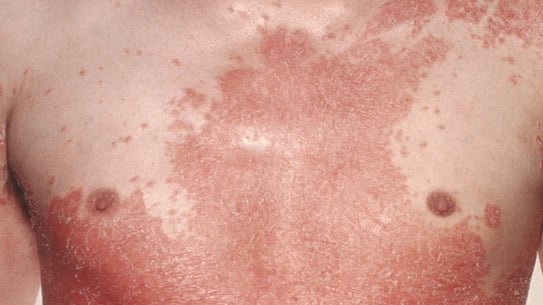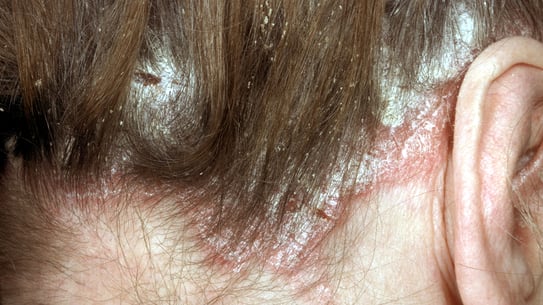1 professionals
Psoriasis: Clinic, diagnosis and treatment
Psoriasis: Clinic, diagnosis and treatment
URL copied
Medical editor: Dr. Pierre Schneider, Dermatologist, Saint-Louis Hospital, France.
Related topics
It is very important for health professionals to recognize and understand the various clinical forms of psoriasis so that they can prescribe a relevant treatment and a comprehensive care package2.
Fig: Erythrodermic phenotype psoriasis

Psoriasis can damage the skin in specific areas:
Fig: Psoriasis on the scalp

Psoriasis can affect the genitals, triggering painful and itchy sensations1.
Fig: Nail psoriasis

There are several ways of assessing the severity of psoriasis:
This scale measures the severity of psoriasis by assessing the surface area and severity of skin plaques, as well as inflammation and scaling4.
This scale measures the severity of nail damage by psoriasis3.
This scale measures the impact of psoriasis on the patients’ quality of life5.
Psoriasis is a chronic disease, which can trigger complications when not treated properly. Health professionals must be aware of the possible complications triggered by psoriasis to ensure that they provide patients with a comprehensive treatment2.
Psoriasis can trigger metabolic complications such as diabetes, heart diseases and disorders of lipid metabolism.
This skin disease is characterized by thick, itchy patches similar to psoriasis1.
Fig 1,2: Lichen planus


There are several treatments available for patients with psoriasis, ranging from topical treatments such as topical creams and ointments, to systemic treatments such as oral medications and biological therapies2.
These cases require hospitalization and care by specialized teams.
Generalized pustular psoriasis: what are the risks for pregnant women? Are they any effects on the baby?
What measures can be taken to prevent a flare-up?
Is there a recurring effect from pregnancy or postpartum?
Should swimming pools be avoided?
Should a pregnant woman who was affected with psoriasis in the early stages of pregnancy be referred to a dermatologist? Should her treatment be adapted to prevent the lesions from getting worse during pregnancy?
Create easily your professional account
I create my accountAccess exclusive business services unlimited
Access valuable features : audio listening & tools sharing with your patients
Access more than 150 product sheets, dedicated to professionals
